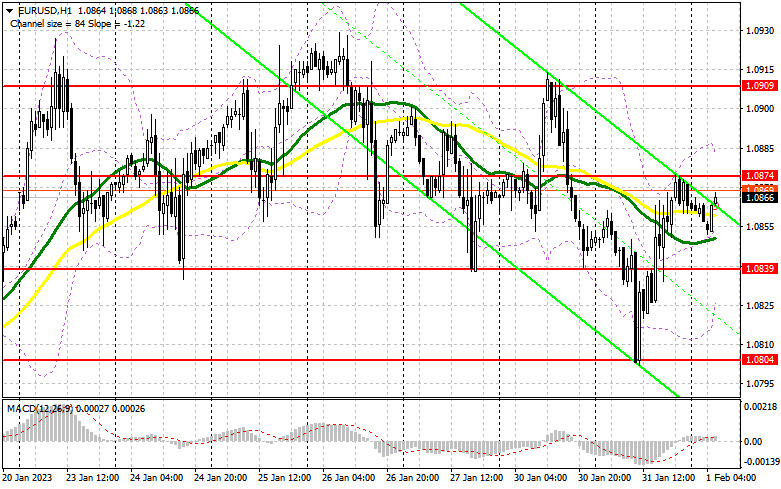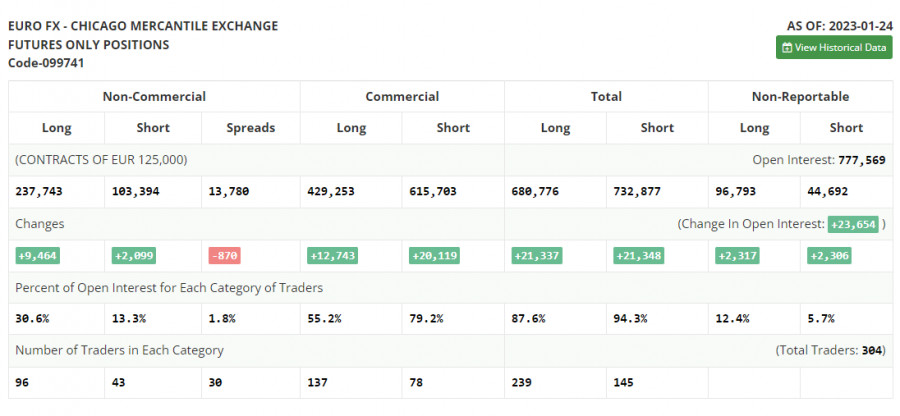
Yesterday, there were good signals to enter the market. Let's take a look at the 5-minute chart to figure out what happened. Earlier, I asked you to focus on the level of 1.0840 to decide when to enter the market. The euro fell to 1.0840 before the eurozone GDP report was released, and a false breakout resulted in a buy signal. As a result, the pair rose by more than 50 pips. In the afternoon, the bears actively defended the resistance at 1.0857, which gave a sell signal, but the movement was only about 20 pips, because the US data was quite negative.

Conditions for opening long positions on EUR/USD:
First half of the day promises to be quite interesting since several macro data will be released which directly affect many European countries. Manufacturing PMIs will be released in Germany, Italy and the eurozone in general, but the inflation report is more important. The eurozone Consumer Price Index (CPI) is projected to fall to 9.0% in January, but the core inflation rate is far more important, where growth is projected. If that happens, the euro will have a chance to further recover even after the Federal Reserve meeting. The eurozone unemployment rate will not play such an important role. What should we do before the Fed meeting and what to expect from it: we will discuss the whole thing in the forecast for the US session.
In case the euro is under pressure during the European session, I will open long positions only after a false breakout down to 1.0839, like I did above. The target is 1.0874, which is where the pair is trading right now. A breakout and a downward test of this level will give a buy signal and allow the pair to reach 1.0909, but I don't expect the euro to rise till the Fed meeting. The bears' stop orders will also be hit if this level is broken, adding another signal and the potential for a move to 1.0956, where it is better to lock in profits. If the euro/dollar pair declines and bulls fail to protect 1.0839, the euro may show a deeper correction in the morning. The fact is that a return below this level will violate the formation of a new bullish trend. That is why traders will focus on the next support at 1.0804. It is also possible to go long just after a bounce off the low of 1.0770, or even lower - around 1.0732, expecting an upward correction of 30-35 pips within the day.
Conditions for opening short positions on EUR/USD:
The fact that the bears couldn't even keep the pair at the new weekly lows speaks for itself. We can see how active the bulls are every time the pair moves down, so there are plenty of people who want to buy the risky assets, even at the current levels. This makes it much more difficult for the bears. Now they need to focus on regaining control of 1.0839, which was reached yesterday. Only this will allow the correction to progress further and take the pair back to the weekly lows. However, the key aim is to protect the resistance at 1.0874.
If the euro/dollar pair jumps during the European session, after a weak manufacturing PMI, an unsuccessful settlement above this level, like yesterday, will lead to a sell signal with the target at 1.0839, where the real struggle will start. A breakout and a reverse test of 1.0839 will give an additional sell signal with the target at 1.0804. A settlement below this area will cause a deeper drop to 1.0770, but this will only be possible after the Fed meeting and if the central bank makes hawkish comments. It is better to lock in profits at this level. If the euro/dollar pair increases during the European session and bears fail to protect 1.0874, traders should not panic. It is better to avoid short orders until the price hits 1.0909, where it is possible to sell after an unsuccessful settlement. Traders may go short just after a rebound from the high of 1.0956, expecting a decrease of 30-35 pips.

COT report:
According to the COT report from January 24, the number of both long and short positions increased. Traders who were encouraged by the European Central Bank's officials last week continued to build up their long positions, as they expect aggressive moves from the central bank, as well as less aggressive policy from the Federal Reserve, which may revise the key interest rate hike. Quite weak fundamental data on the US economy, especially a decline in retail sales in December, points to how the overall situation is deteriorating in the country. It means that further monetary policy tightening may lead to even more negative results. Central bank meetings will take place this week, which will determine the pair's future direction. The COT report unveiled that the number of long non-commercial positions rose 9,464 to 237,743, while the number of short non-commercial positions jumped 2,099 to 103,394. At the end of the week, the total non-commercial net position was up 134,349 versus 126,984. All this suggests that investors believe in further growth in the euro but are still waiting for the central banks to paint a better picture on future interest rates. The weekly closing price rose to 1.0919 vs. 1.0833.

Signals of indicators:
Moving Averages
Trading is carried out around the 30 and 50 daily moving averages, which indicates market uncertainty.
Note: The author considers the period and prices of moving averages on the one-hour chart which differs from the general definition of the classic daily moving averages on the daily chart.
Bollinger Bands
In case of growth, the upper limit of the indicator at 1.0880 will act as resistance. In case the pair falls, the lower limit of the indicator located at 1.0820 will act as support.
Description of indicators
Moving average (a moving average determines the current trend by smoothing volatility and noise). The period is 50. It is marked in yellow on the chart.Moving average (a moving average determines the current trend by smoothing volatility and noise). The period is 30. It is marked in green on the graph.MACD indicator (Moving Average Convergence/Divergence - convergence/divergence of moving averages). A fast EMA period is 12. A slow EMA period is 26. The SMA period is 9.Bollinger Bands. The period is 20.Non-profit speculative traders are individual traders, hedge funds, and large institutions that use the futures market for speculative purposes and meet certain requirements.Long non-commercial positions are the total number of long positions opened by non-commercial traders.Short non-commercial positions are the total number of short positions opened by non-commercial traders.The total non-commercial net position is a difference in the number of short and long positions opened by non-commercial traders.